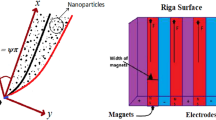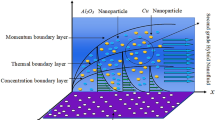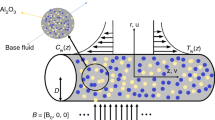Abstract
The vertical microchannels phenomenon is useful in the cooling process of microelectronic devices, fuel cells and MHD (magnetohydrodynamic) micro-pumps. The understanding of this phenomenon makes these flows crucial in industries and engineering products. Objective of this paper is how Dufour, Soret and chemical reaction affect the characteristics of hybrid nanofluid (engine oil + manganese zinc ferrite (\(({\text{MnZnFe}}_{2} {\text{O}}_{4} )\) + nickel zinc ferrite \(({\text{NiZnFe}}_{2} {\text{O}}_{4} )\))) flow in a microchannel with two vertical parallel plates. The irreversibility analysis is considered. The bvp4c solver in MATLAB is implemented to compute the transformed system derived from the equations used to describe the present problem. The heat transfer rate and other physical parameters of relevance near both plates are explained using graphs. It has been observed that as the Brinkman number and Dufour numbers increased, the entropy production rate is significantly changed. It is noticed that there is a reduction in Bejan number with the escalation in volume fraction of \({\text{NiZnFe}}_{2} {\text{O}}_{4}\) (\(\phi_{{{\text{Ni}}}}\)). The skin-friction factor declined with the rate of 0.03114 at \(0 \le {\text{Mn}} \le 3\) (near left plate) and decreased in the friction factor is 2.45896 when \(\phi_{{{\text{Ni}}}}\) is in the range \(0 \le \phi_{{{\text{Ni}}}} \le 0.09\) (near right plate). It is detected that when Dufour number (\({\text{Du}}\)) is at \(0 \le {\text{Du}} \le 0.6\), heat transmission rate cuts down by 0.06935 (near the left plate). Sherwood number risen by 0.043153 (near the left plate) when Soret number (\({\text{Sr}}\)) is set to \(0 \le {\text{Sr}} \le 0.6\).















Similar content being viewed by others
Abbreviations
- \(u,v\) :
-
Velocity components in \(x,y\) directions
- \(p\) :
-
Pressure
- \(\kappa\) :
-
Permeability of porous medium
- \(k_{{\text{T}}}\) :
-
Thermal mean temperature
- \({\text{Br}}\) :
-
Brinkman number
- \(c_{{\text{s}}}\) :
-
Concentration susceptibility
- \(\mu\) :
-
Dynamic viscosity
- \(\rho\) :
-
Density
- \(\sigma\) :
-
Electrical conductivity
- \({\text{St}}\) :
-
Schmidt number
- \(C_{{\text{p}}}\) :
-
Specific heat capacity
- \(\Pr\) :
-
Prandtl number
- \(k*\) :
-
Mean absorption coefficient
- \(k_{0}\) :
-
Chemical reaction rate parameter
- \(\upsilon\) :
-
Kinematic viscosity
- \(k\) :
-
Thermal conductivity
- \(\phi_{1}\) :
-
Volume fraction of \({\text{NiZnFe}}_{2} {\text{O}}_{4}\)
- \({\text{Sr}}\) :
-
Soret number
- \(\phi_{2}\) :
-
Volume fraction of \({\text{MnZnFe}}_{2} {\text{O}}_{4}\)
- \(\eta\) :
-
Similarity variable
- \(\sigma *\) :
-
Stefan–Boltzmann constant
- \(T_{{\text{m}}}\) :
-
Fluid mean temperature
- \(\delta\) :
-
Pressure gradient parameter
- \(\Lambda\) :
-
Porosity parameter
- \({\text{Cr}}\) :
-
Reaction rate parameter
- \(D_{{\text{m}}}\) :
-
Molecular diffusivity
- \({\text{Mn}}\) :
-
Magnetic field parameter
- \({\text{Bi}}_{1}\) :
-
Biot number near left plate
- \({\text{Bi}}_{2}\) :
-
Biot number near right plate
- \(h_{{\text{i}}}\) :
-
Convective heat transfer coefficient
- \({\text{Rd}}\) :
-
Thermal radiation parameter
- \(\tilde{R}\) :
-
Universal gas constant
- \(E_{{\text{G}}}\) :
-
Entropy generation parameter
- \(G\) :
-
Diffusion parameter
- \({\text{Re}}\) :
-
Reynolds number
- \({\text{Du}}\) :
-
Dufour number
- \(\beta\) :
-
Concentration ratio parameter
- \(\alpha\) :
-
Temperature difference parameter
References
Ho CJ, Huang JB, Tsai PS, Yang YM. On laminar convective cooling performance of hybrid water-based suspensions of Al2O3 nanoparticles and MEPCM particles in a circular tube. Int J Heat Mass Transf. 2011;54(11–12):2397–407.
Izadi MM, Shahmardan MM, Maghrebi MJ, Behzadmehr A. Numerical study of developed laminar mixed convection of Al2O3/water nanofluid in an annulus. Chem Eng Commun. 2013;200(7):878–94.
Madhesh D, Kalaiselvam S. Experimental analysis of hybrid nanofluid as a coolant. Procedia Eng. 2014;97:1667–75.
Izadi M, Shahmardan MM, Norouzi M, Rashidi AM, Behzadmehr A. Cooling performance of a nanofluid flow in a heat sink microchannel with axial conduction effect. Appl Phys A. 2014;117:1821–33.
Izadi M, Behzadmehr A, Shahmardan MM. Effects of inclination angle on mixed convection heat transfer of a nanofluid in a square cavity. Int J Comput Methods Eng Sci Mech. 2015;16(1):11–21.
Das S, Jana RN, Makinde OD. MHD flow of Cu–Al2O3/water hybrid nanofluid in porous channel: analysis of entropy generation. Defect Diffus Forum. 2017;377:42–61.
Turkyilmazoglu M. Algebraic solutions of flow and heat for some nanofluids over deformable and permeable surfaces. Int J Numer Meth Heat Fluid Flow. 2017;27(10):2259–67.
Afridi MI, Tlili I, Goodarzi M, Osman M, Khan NA. Irreversibility analysis of hybrid nanofluid flow over a thin needle with effects of energy dissipation. Symmetry. 2019;11(5):663.
Hayat T, Nadeem S, Khan AU. Rotating flow of Ag–CuO/H2O hybrid nanofluid with radiation and partial slip boundary effects. Eur Phys J E. 2018;41(6):1–9.
Mehryan SA, Ghalambaz M, Chamkha AJ, Izadi M. Numerical study on natural convection of Ag–MgO hybrid/water nanofluid inside a porous enclosure: a local thermal non-equilibrium model. Powder Technol. 2020;367:443–55.
Waini I, Ishak A, Groşan T, Pop I. Mixed convection of a hybrid nanofluid flow along a vertical surface embedded in a porous medium. Int Commun Heat Mass Transf. 2020;114: 104565.
Izadi M, Sheremet MA, Mehryan SA. Natural convection of a hybrid nanofluid affected by an inclined periodic magnetic field within a porous medium. Chin J Phys. 2020;65:447–58.
Jamshed W, Devi SU, Nisar KS. Single phase based study of Ag–Cu/EO Williamson hybrid nanofluid flow over a stretching surface with shape factor. Phys Scr. 2021;96(6): 065202.
Jafarimoghaddam A, Turkyilmazoglu M, Roşca AV, Pop I. Complete theory of the elastic wall jet: a new flow geometry with revisited two-phase nanofluids. Eur J Mech B/Fluids. 2021;86:25–36.
Bilal M, Gul T, Alsubie A, Ali I. Axisymmetric hybrid nanofluid flow with heat and mass transfer amongst the two gyrating plates. ZAMM-J Appl Math Mech Zeitschrift für Angewandte Mathematik und Mechanik. 2021;101(11): e202000146.
Xiong Q, Tayebi T, Izadi M, Siddiqui AA, Ambreen T, Li LK. Numerical analysis of porous flat plate solar collector under thermal radiation and hybrid nanoparticles using two-phase model. Sustain Energy Technol Assess. 2021;47: 101404.
Kamel MS, Lezsovits F, Abdollahi A, Izadi M. Amelioration of pool boiling thermal performance in case of using a new hybrid nanofluid. Case Stud Therm Eng. 2021;24: 100872.
Zangooee MR, Hosseinzadeh K, Ganji DD. Hydrothermal analysis of hybrid nanofluid flow on a vertical plate by considering slip condition. Theor Appl Mech Lett. 2022;12(5): 100357.
Venkateswarlu A, Murshid N, Mulki H, Abu-samha M, Suneetha S, Babu MJ, Raju CS, Homod RZ, Al-Kouz W. A significant role of activation energy and Fourier flux on the quadratically radiated sphere in low and high conductivity of hybrid nanoparticles. Symmetry. 2022;14(11):2335.
Babu MJ, Rao YS, Kumar AS, Raju CS, Shehzad SA, Ambreen T, Shah NA. Squeezed flow of polyethylene glycol and water based hybrid nanofluid over a magnetized sensor surface: a statistical approach. Int Commun Heat Mass Transf. 2022;135: 106136.
Rahman M, Sharif F, Turkyilmazoglu M, Siddiqui MS. Unsteady three-dimensional magnetohydrodynamics flow of nanofluids over a decelerated rotating disk with uniform suction. Pramana. 2022;96(4):170.
Izadi M, Alshehri HM, Hosseinzadeh F, Rad MS, Hamida MB. Numerical study on forced convection heat transfer of TiO2/water nanofluid flow inside a double-pipe heat exchanger with spindle-shaped turbulators. Eng Anal Bound Elem. 2023;150:612–23.
Mahian O, Kianifar A, Kleinstreuer C, Moh’d AAN, Pop I, Sahin AZ, Wongwises S. A review of entropy generation in nanofluid flow. Int J Heat Mass Transf. 2013;65:514–32.
Sheikholeslami M, Ashorynejad HR, Rana P. Lattice Boltzmann simulation of nanofluid heat transfer enhancement and entropy generation. J Mol Liq. 2016;214:86–95.
Ebrahimi A, Rikhtegar F, Sabaghan A, Roohi E. Heat transfer and entropy generation in a microchannel with longitudinal vortex generators using nanofluids. Energy. 2016;101:190–201.
Shahsavar A, Sardari PT, Toghraie D. Free convection heat transfer and entropy generation analysis of water-Fe3O4/CNT hybrid nanofluid in a concentric annulus. Int J Numer Methods Heat Fluid Flow. 2018;29(3):915–34.
Khan MI, Hayat T, Alsaedi A. Numerical investigation for entropy generation in hydromagnetic flow of fluid with variable properties and slip. Phys Fluids. 2018;30(2): 023601.
Khan MI, Qayyum S, Hayat T, Alsaedi A. Entropy generation minimization and statistical declaration with probable error for skin friction coefficient and Nusselt number. Chin J Phys. 2018;56(4):1525–46.
Sohail M, Naz R, Abdelsalam SI. On the onset of entropy generation for a nanofluid with thermal radiation and gyrotactic microorganisms through 3D flows. Phys Scr. 2020;95(4): 045206.
Ahmad S, Nadeem S, Ullah N. Entropy generation and temperature-dependent viscosity in the study of SWCNT–MWCNT hybrid nanofluid. Appl Nanosci. 2020;10(12):5107–19.
Zhao TH, Khan MI, Chu YM. Artificial neural networking (ANN) analysis for heat and entropy generation in flow of non‐Newtonian fluid between two rotating disks. Math Methods Appl. Sci. 2021;1–19.
Nayak MK, Mabood F, Dogonchi AS, Khan WA. Electromagnetic flow of SWCNT/MWCNT suspensions with optimized entropy generation and cubic auto catalysis chemical reaction. Int Commun Heat Mass Transf. 2021;120: 104996.
Liu S, Bahrami D, Kalbasi R, Jahangiri M, Lu Y, Yang X, Band SS, Chau KW, Mosavi A. Efficacy of applying discontinuous boundary condition on the heat transfer and entropy generation through a slip microchannel equipped with nanofluid. Eng Appl Comput Fluid Mech. 2022;16(1):952–64.
Mahesh A, Raju CS, Babu MJ, Madhusudhana Rao B, Varma SV, Prasannakumara BC. Entropy generation optimization in an unsteady hybrid nanofluid flow between two rotating disks: a numerical bioconvection model. Waves Random Complex Media. 2022;1–32.
Akhter R, Ali MM, Alim MA. Entropy generation due to hydromagnetic buoyancy-driven hybrid-nanofluid flow in partially heated porous cavity containing heat conductive obstacle. Alex Eng J. 2023;62:17–45.
Reedy S, Srihari P, Ali F, Naikoti K. Numerical analysis of Carreau fluid flow over a vertical porous microchannel with entropy generation. Partial Differ Equ Appl Math. 2022;5: 100304.
Rao DP, Thiagarajan S, Srinivas KV. Significance of Dufour and Soret effects on the non-Darcy flow of cross fluid by a tilted plate with radiation and chemical reaction: a Cattaneo–Christov heat flux model. Heat Transf. 2022;51(2):1585–600.
Tahir H, Khan U, Din A, Chu YM, Muhammad N, Li XM. Hybridized two phase ferromagnetic nanofluid with NiZn–Fe2O4 and MnZn–Fe2O4. Ain Shams Eng J. 2021;12(3):3063–70.
Faiz M, Habib D, Siddique I, Awrejcewicz J, Pawłowski W, Abdal S, Salamat N. Multiple slip effects on time dependent axisymmetric flow of magnetized Carreau nanofluid and motile microorganisms. Sci Rep. 2022;12(1):1–4.
Author information
Authors and Affiliations
Contributions
DPCR was involved in the investigation, data curation and formal analysis. MJB contributed to writing—original draft, data curation and software. SAS assisted in the validation, visualization, technical review and visualization. SQ contributed to the visualization, supervision and conceptualization.
Corresponding authors
Additional information
Publisher's Note
Springer Nature remains neutral with regard to jurisdictional claims in published maps and institutional affiliations.
Rights and permissions
Springer Nature or its licensor (e.g. a society or other partner) holds exclusive rights to this article under a publishing agreement with the author(s) or other rightsholder(s); author self-archiving of the accepted manuscript version of this article is solely governed by the terms of such publishing agreement and applicable law.
About this article
Cite this article
Rao, D.P.C., Babu, M.J., Shehzad, S.A. et al. Entropy generation optimization in a radiative hybrid nanofluid (engine oil + NiZnFe2O4 + MnZnFe2O4) flow through a convectively heated microchannel with cross-diffusion effects. J Therm Anal Calorim 148, 10907–10916 (2023). https://doi.org/10.1007/s10973-023-12412-w
Received:
Accepted:
Published:
Issue Date:
DOI: https://doi.org/10.1007/s10973-023-12412-w




